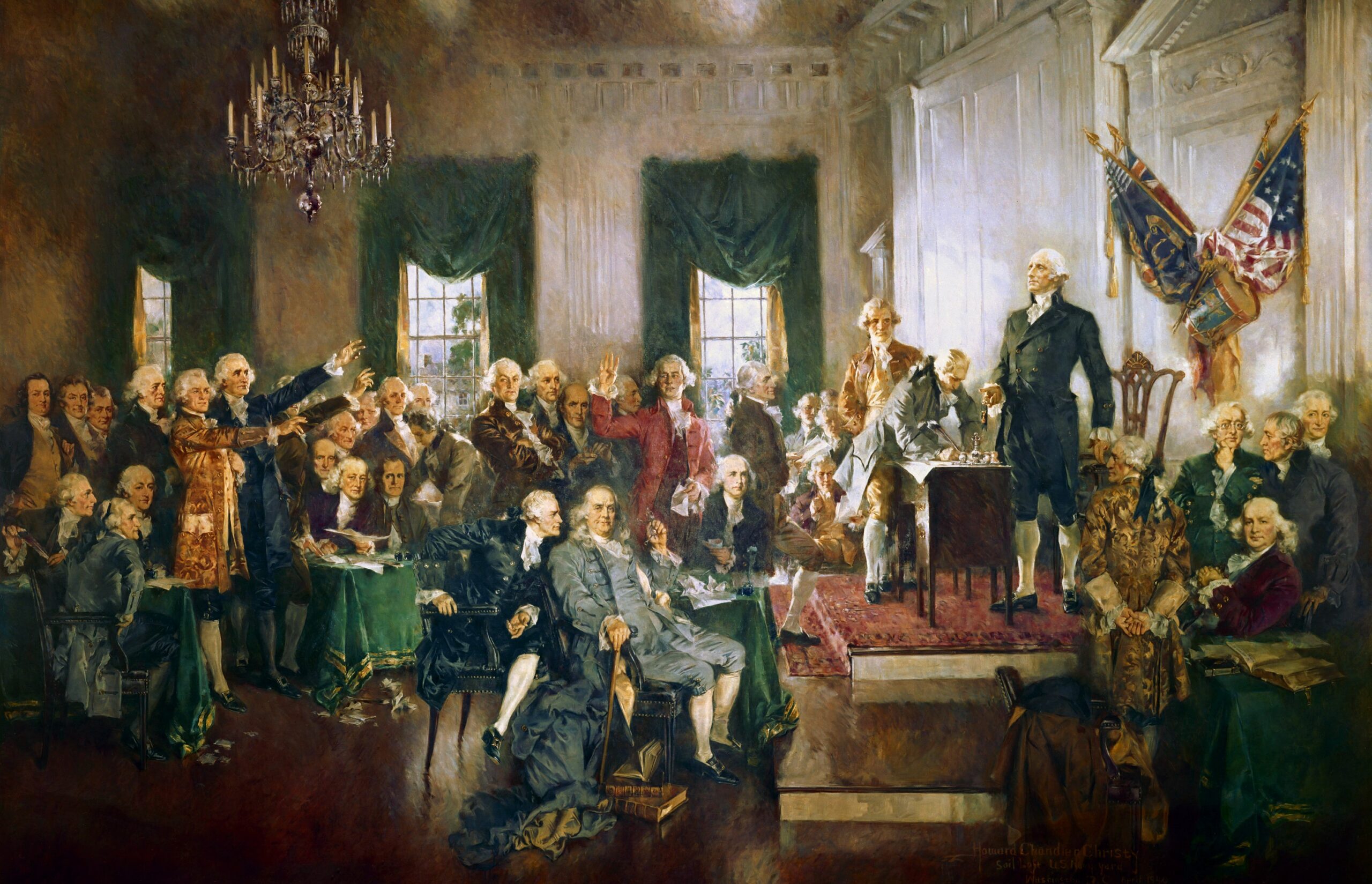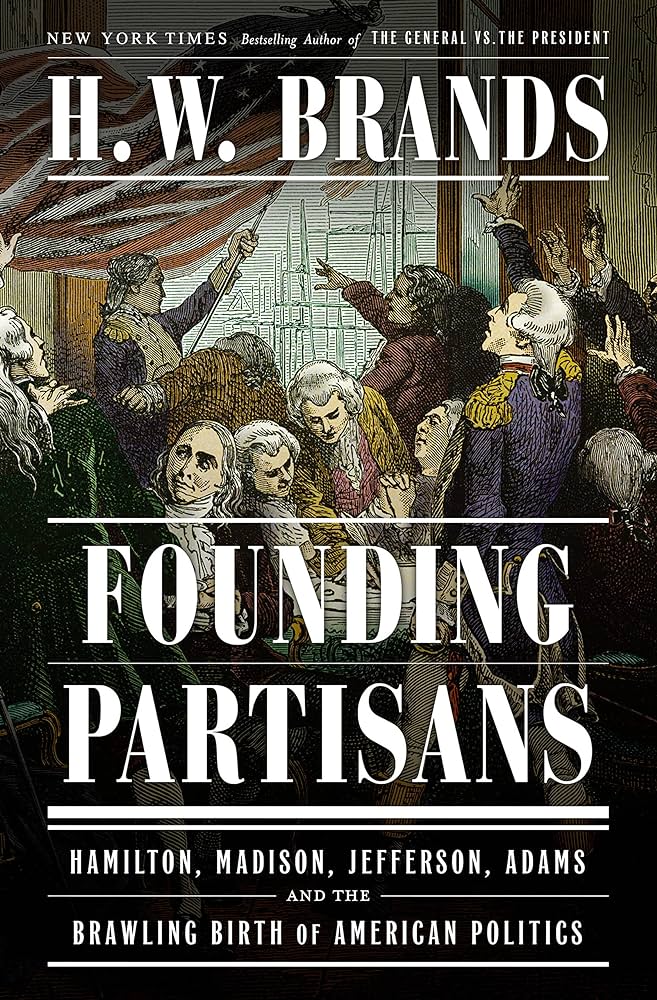H W. Brands here undertakes to tell the story of American federal politics down through the Revolution of 1800. He does so chiefly through the writings, public and private, of the Federalist era’s four leading political figures. His approach will pay dividends for those new to the period, as the four of them were remarkable writers and thinkers, besides alluring politicians.
The story opens with the protagonists’ uncertainty about the outcome of the presidential election of 1800. Thomas Jefferson’s Republican party has won, but the House of Representatives could make either Republican candidate, Jefferson or Aaron Burr, president. Alexander Hamilton writhes at the thought of the choice. President John Adams takes it worse. Characteristically, Hamilton makes his decision: it must be Jefferson, for Burr is an American Catiline. Of Jefferson, he can say, “His politics are tinctured with fanaticism . . . he is too much in earnest in his democracy . . . he has been a mischievous enemy to the principal measures of our past administration . . . he is not scrupulous about the means of success, nor very mindful of truth . . . he is a contemptible hypocrite.” Still, the Virginian is preferable to Senator Burr.
Jefferson, for his part, “professed detachment as the skulduggery unfolded,” Brands says. He accepts Jefferson’s insistence that he had no desire to become president as factual—as indeed the evidence says we must, though Jefferson did accept the post. He had always accepted the post, whether as burgess, congressman, diplomat, governor, secretary of state, or vice president. “As much as he looked forward to the quiet of retirement,” Brands says, “he couldn’t turn away at the moment of victory.”
Artfully, Brands next gives us a lengthy flashback through Hamilton’s political career. He entitles this section “The Making of a Continentalist,” alluding to a notably incisive, persuasive series of newspaper essays Hamilton had written over a decade earlier. An army officer at the time, he had wanted to reform the federal political system to make the Continental Congress stronger. The character sketch with which this section is introduced provides in a few pages a sharp portrait of the man and an explanation of the motives underlying his political career. Brands has particular skill in summarizing without losing detail. In this he is unlike his subject, who was both a persuasive penman and prone to verbosity, not to say prolixity.
Brands soon has Hamilton trying to use a mutiny for political purposes. George Washington refuses to go along. Before long, in 1786–87, Shays’ Rebellion offers another opportunity to argue for increased power in the central government. We are told that “people had begun to live beyond their means,” but substantial changes in the tax laws of Massachusetts—essentially making it impossible for farmers in the Bay State’s inland counties to meet their legal obligations—are ignored by the author. Here is a manifest flaw in Brands’s research base, which seems generally to have been limited to the major figures’ correspondence. Ironically, that leaves him in much the same position as that of George Washington, as several correspondents from different states strove to use Shays’ Rebellion as the fulcrum for moving a highly resistant Washington to abandon his retirement from public life to seek amendments (at least) to the Articles of Confederation.
The Annapolis Convention—the first shot at the objective finally achieved by the more famous conclave at Philadelphia the following summer—goes by quickly, and soon the “Conspiracy at Philadelphia” is upon us. What exactly it means to call the Philadelphia Convention a “conspiracy,” let alone to say that James Madison “intended to usurp the authority of state legislatures,” is unclear. The Philadelphia Convention could only make recommendations to Congress. Giving those recommendations effect would require action by Congress, then the state governments, and ultimately the sovereign peoples of the states.
One finds in this account of the run-up to Philadelphia the chief bits of Madison’s correspondence—with Washington, with Edmund Randolph, with Jefferson—about his plans for the convention. (Curiously, Delaware becomes “the smallest of the states.” Perhaps Brands means “in attendance at Philadelphia.”) In general, this account is not analytical but relays the most famous examples of speechifying that occurred at the gathering. We do find New Jersey’s William Paterson complaining that his colleagues were bent on proposing more far-reaching changes to the federal system than Congress had contemplated in calling for a convention, but the majority trudged ahead.
Hamilton, silent through the convention’s early weeks, at last rouses himself to blast “demagogues” who resist transforming a federal union into a national one. In general, he is far more strident than his colleagues. Shays’ Rebellion, he insists, proved that a federal government would not suffice: a national one it must be. Thus, even the Virginia Plan, far more ambitious than Paterson’s alternative, would be inadequate. He at last lays out the scheme for a highly centralized government, with a president for life appointing senators for life and a lower house of Congress serving five-year terms; his centralizing vision would form the nub of party division in the following decade. James Madison and the Virginians, from Hamilton’s perspective, propose “pork still, with a little change of the sauce.”
In the wake of this momentous speech, Madison took advantage of an opportunity. His centralizing Virginia Plan could be a midpoint between New Jersey’s and Hamilton’s proposals. Still Madison, speaking for the most populous, most extensive state, hammered home the idea that population must be the basis of both houses’ apportionment. Hamilton, explaining himself, conceded that he did not think much of republican government.
Interspersed among snippets of the Philadelphia Convention in Brands’s account are several anecdotes about the Great Men in their off hours, which make them seem ordinary mortals. Not all of Dr. Franklin’s time was spent thinking Deep Thoughts.
Unable to coax the less populous states into agreeing that both houses of the new Congress should be apportioned by population, Madison offers up an assertion that not populousness but slavery is the chief dividing line among the states, “and if any defensive power were necessary, it ought to be mutually given to these two interests.” Alas, we have no catalog of John C. Calhoun’s library, but it would be unsurprising to learn that he had owned a copy of the debates in the Philadelphia Convention.
As in Calhoun’s day, in 1787 this proposal went over like the proverbial lead zeppelin. In the end, delegates for and against slave representation agreed that each bondman would count as three-fifths of a person for purposes both of tax allocation among the states and of representative apportionment in the lower house of Congress. To Gouverneur Morris’s repeated remarks insisting that slaves should not count at all because slavery was iniquitous, Connecticut’s Roger Sherman replied, “The morality or wisdom of slavery are [sic] considerations belonging to the states themselves.” South Carolina’s Charles Pinckney added that his state would “never receive the plan if it prohibits the slave trade.” In the end, the Constitution left that question to the states until 1808, a period during which South Carolina imported scores of thousands of additional unfree laborers. Unlike many accounts, Brands’s book makes clear that Madison left Philadelphia dissatisfied, but Brands goes around the bend in saying the Convention committed a “coup”: all it did was to submit a proposal to Congress.
The remaining sections of the book are “Monarchists and Jacobins,” “Aliens and Seditionists,” and “The Revolution of 1800.” Readers familiar with the outlines of the story will find little that is new here. Washington’s presidency yields party division despite the expectations of virtually everyone involved; President John Adams leads the new republic into an undeclared war with . . . that other new republic, the one across the ocean; and Adams and Jefferson grow to despise each other’s political personae. Principle underlies the division, certainly, but so does a good bit of ambition, pride, and vanity. (Adams’s correspondence, at least, is far more unvarnished than what Jefferson left us, which is voluminous.)
Brands generally gets the main issues right, though one does find cause to quarrel from time to time. For example, Marbury v. Madison did not offend Jeffersonians’ “philosophy of popular rule.” In fact, when he first saw the unamended Constitution, Jefferson told Madison it should be amended to add a bill of rights, and one argument he made was that judges such as Virginia’s three best could make good use of such amendments. In other words, he was contemplating judicial review. What Republicans disliked about Marbury, to the point of being spitting mad, was the unnecessary political lecture that preceded the jurisdictional issue, which should have been the only thing John Marshall’s Supreme Court addressed. There would be many more such episodes ere Jefferson, Marshall, and the rest were done.
This book is a nice introduction to American high politics in its earliest years. Laymen will find it entertaining, as perhaps will those more familiar with the story, but experts are unlikely to find anything in it they have not seen before.
















